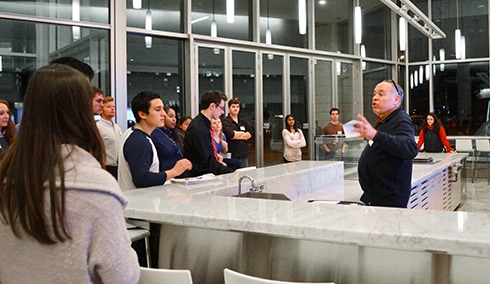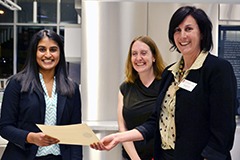
If a well-known but empty space on campus finds a use in the near future, it just might be because of a unique collaboration between the Wisconsin School of Business (WSB) and the UW–Madison Department of English.
Spring 2016 saw the launch of a new contest, Business and English Students Together (BEST), which joined students from both disciplines to find a solution to a real-world problem on campus. Seven teams comprised of a mix of business and English students came up with a variety of ideas for an unused space called “Rennie’s Corner” at the Wisconsin Institutes for Discovery.
“At first I thought, ‘Why would you combine business and English?” says Amanda Samuel (BBA ’17), whose essay about the experience won one of the contest’s prizes. “But they integrate more than you would think at first glance.”
That integration was the impetus behind the contest. The funding and idea for it came from Alan Chesler (B.S. ’85, M.S. ’87), a WSB real estate alumnus who is co-founder of Ehrenberg Chesler Investment Bankers in San Antonio, Texas. Chesler credits the communications skills he learned as an undergraduate majoring in English and economics with helping his success in the business world, and he wanted to help prepare WSB students in that way, too.
Chesler and Caroline Levine, chair of the English department, collaborated with Suzanne Dove, assistant dean for academic innovations at the Wisconsin School of Business, to turn the idea into action.
“We liked this idea of there being a problem that people had to work together to solve,” Dove says. “It’s a great opportunity to inspire learning with the extended community and have the students benefit from networking during an active learning experience.”
Real-world problem
Levine came up with the BEST contest “problem” because she served on a committee that was trying to find a use for Rennie’s Corner. Its original use shortly after the Wisconsin Institutes for Discovery opened in 2010 was as a dairy bar serving Babcock Hall ice cream, but it closed shortly after. The marble bar and stools of the one-time ice cream parlor have sat mostly unused for years.
Students were presented the challenge at an event at Rennie’s Corner, then given two weeks to create a proposal that they would pitch in a five-minute presentation.

The winning pitch came from Alec Prueter (BBA ’16), Louisa Frye (BBA ’17), and Elizabeth Kinsella (B.A. ’16). The trio proposed turning the space into a place to host “WIdea”—a Wisconsin Idea-inspired version of the popular TED Talks video series. With WIdea, students, faculty, and community members could give a talk on a topic in their area of expertise. It might be to demonstrate computer or iPhone shortcuts, discuss current issues, or something as simple as offering a few tips on how to cook when you don’t have a kitchen. The person giving the talk would be behind the bar, and the audience would be seated at or standing around the bar.
“We wanted to bridge the gap between a social bar environment and a lecture hall to eliminate the intimidation and bring in the idea of education to a social space,” Prueter says.
Finding value in an idea
It wasn’t just brainstorming an idea, however. Students surveyed and interviewed fellow students and campus and community members to find out if the idea had any appeal. That was an instrumental part of the process, and something outlined to the contest participants by John Surdyk, director of the WSB’s Initiative for Studies in Transformational Entrepreneurship.
“All of the teams took seriously the value proposition that John talked to them about. You could have a great idea and nobody would want it, so how do you identify an actual problem or desire people don’t even know that they have?” Levine says. “So they had to talk to customers about the design of the space, and they all took those pieces seriously.”
The main “customer” of WIdea, Frye says, was upperclassmen who were dedicated to their majors, but still had a variety of interests they wanted to pursue.
“The idea of branching outside of your major can be really tough,” she says. “As you get to be a senior, your education can get very narrow to your major, and we liked the idea of having sessions where you can go and learn other things outside your major that you might not otherwise be learning on a daily basis.”
The students won $2,000 for making the best pitch to the judging panel made up of people who worked or have worked in business, with a mix of business and humanities education. The students with the winning pitch also received $500 to donate to the UW–Madison unit of their choice; Prueter, Frye, and Kinsella chose the English department.
Besides Chesler’s prize contribution, Wisconsin Alumni Research Foundation added a prize up to $2,500 as seed money for the most feasible idea. Three other ideas from the BEST contest advanced to qualify for that. The students behind the ideas are fine-tuning them.
Reflecting on the experience
Another component of the contest was a two-page paper in which students were asked to reflect on their experience working on their projects, what they learned about themselves, and what they learned from their teammates. BBA student Amanda Samuel won the $200 prize in that category.

Samuel thought she was a great fit for the contest because she had studied similar problem-solving situations as a marketing major. But she found that her teammates—Laura Sievert (BBA ’18), Ethan Kay (B.S. ’16), and Aaron Kelly (B.S. ’18)—brought even stronger skills than she realized.
“I found the people I worked with just brought in more creativity,” she says. “My paper was how I took a back seat, how I learned to do that, and how that was okay.”
Next year’s contest problem hasn’t been determined yet, but Dove and Levine hope the BEST contest continues. The collaboration between the two departments is valuable, Dove says, and benefits all of the students.
“One of the reasons I’m so excited about this BEST challenge is I’ve been giving a lot of thought to figuring out how our students can do
a better job of connecting what they take in the liberal arts at the College of Letters and Science with the rest of their business curriculum at WSB,” Dove says. “It shouldn’t be just an add-on or something they take to fulfill a requirement. It should be part of the valuable curriculum that will prepare them for success.”
Levine agrees.
“Business schools are being asked to think in a more well-rounded way about education,” Levine says. “And it’s the same moment that English departments are losing students because they don’t think they get the kind of training they need for the workplace.
“We kind of need each other right now, and this was a nice way to start our collaboration.”
Tags: